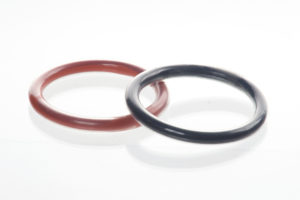Why Choose Teflon® Encapsulated Viton® and Silicone O-Rings?
 Teflon® encapsulated o-rings integrate the high chemical resistance of Teflon® while retaining compression and recovery characteristics of traditional elastomers. This makes Teflon® encapsulated o-rings the best of both worlds in sealing. Additionally, they have excellent dielectric properties, a low coefficient of friction, flexibility, weather resistance, toughness, and negligible moisture absorption. These o-rings are recommended with their ability to outperform traditional elastomeric o-rings in hostile environments over a wide temperature range.
Teflon® encapsulated o-rings integrate the high chemical resistance of Teflon® while retaining compression and recovery characteristics of traditional elastomers. This makes Teflon® encapsulated o-rings the best of both worlds in sealing. Additionally, they have excellent dielectric properties, a low coefficient of friction, flexibility, weather resistance, toughness, and negligible moisture absorption. These o-rings are recommended with their ability to outperform traditional elastomeric o-rings in hostile environments over a wide temperature range.
Why Choose Global O-Ring and Seal for Teflon® Encapsulated O-Rings?
We keep hundreds of sizes in both Viton® and Silicone in stock at our warehouse in Houston, TX. Factory stock orders for these items can be shipped standard to arrive within five business days. For more information or to request a quote, please submit the Product Inquiry form or give us a call at 832-448-5550 to speak with one of our technical sales professionals.
Jacket Type and O-Ring Material
Teflon® encapsulated o-rings are made in the following four combinations of jacket type and elastomer:
- Teflon® FEP jacket encapsulating an o-ring core of Viton® (TEV)
- Teflon® FEP jacket encapsulating an o-ring core of Silicone (TES)
- Teflon® PFA jacket encapsulating Viton® (PFAV)
- Teflon® PFA jacket encapsulating Silicone (PFAS)
FEP (fluorinated ethylene propylene): Teflon® FEP encapsulated o-rings offer excellent resistance to a broad range of corrosive chemicals, including alcohols, aromatic solvents, naphtha, acids, and petroleum spirits.
PFA (perfluoroalkoxy-copolymer): Teflon® PFA encapsulated o-rings possess many of the same properties as FEP, but with higher mechanical strength and increased temperature resistance. PFA encapsulation is typically used in applications where extreme thermal stability and durability are required.
| FEP | -76°F to +400°F | FDA-Grade, USP Class VI, and 3-A Sanitary Standards | Low compression set, low coefficient of friction |
| PFA | -76°F to +500°F | FDA-Grade, USP Class VI, and 3-A Sanitary Standards | Long service life, resistance to stress and cracking |
Product Inquiry
Solid or Hollow-Core Design:
Encapsulated o-rings are supplied with either solid or hollow-core energizers. Solid-Core energizers provide the best resistance to compression set and recovery. Hollow-Core o-rings contain a circular gap within the energizer as a way to provide effective sealing for situations where a more flexible, easier-to-squeeze o-ring is required. Global O-Ring and Seal’s standard product is solid-core but hollow-core is available by request. See the profiles for both solid-core and hollow-core o-rings below.
The Right Encapsulated O-Ring is Application-Specific
Choosing the right encapsulated o-ring will depend on the specific requirements of the application. Global O-Ring and Seal carries a full line of encapsulated o-rings in all AS568 standard sizes. Custom sizes are available upon request — as are o-rings with rectangular, oval, and square cross-sectional profiles.
If you are in need of a custom solution, please submit the Product Inquiry form or give us a call at 832-448-5550 to speak with one of our technical sales professionals.
Encapsulated O-Ring Installation Guidelines:
The FEP/PFA encapsulation is a hard material with limited flexibility compared to the fully elastomeric o-ring inside. The encapsulation outer layer can be damaged during installation with excessive stretch or sharp edges on the part.
Heating the o-rings prior to installation and ensuring installation surfaces are free from sharp edges are two key factors in a successful installation.
Encapsulated O-Ring Heating Methods
Hot Water (Recommended)
- Heat water to 100°C / 212°F.
- Place o-rings in water for a minimum of 3 minutes.
- Remove o-rings just prior to installing them.
- If the o-rings become cool, reheat to installation is done while still warm.
Oven Heating
- Set oven to 100°C / 212°F (ensure no excessive temperature fluctuation).
- Place o-rings evenly on backing sheet.
- Heat o-rings for a minimum of 15 minutes (no maximum time limit).
- Install o-ring immediately after removing from the oven.
- If the o-rings become cool, reheat to installation is done while still warm.
* Teflon® and Viton® are Registered Trademarks of the Chemours Company.

 English
English  Español
Español  Français
Français  Português
Português  Deutsch
Deutsch  Italiano
Italiano  Русский
Русский  中文
中文  日本語
日本語  العربية
العربية  हिन्दी
हिन्दी 
